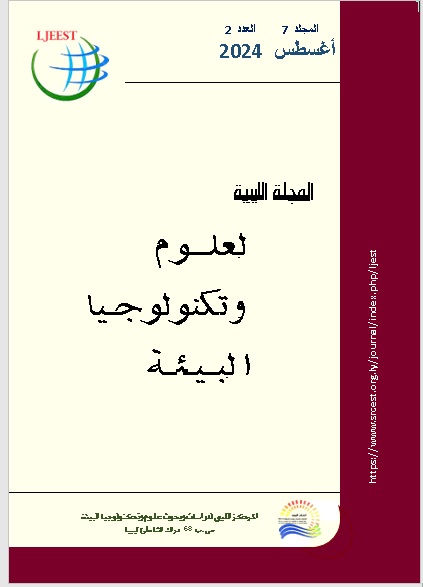القائمة الوطنية والوضع البيئي للقشريات البحرية في المياه الليبية، جنوب البحر المتوسط
DOI:
https://doi.org/10.63359/t5fw9g85الكلمات المفتاحية:
قائمة تجقق، الشاطيء الليبي، غير اصلي، التنوعالملخص
يوفر الشاطي الليبي مواطن بيئية تدعم تنوعًا كبيرًا من القشريات البحرية. تهدف هذه الدراسة إلى تقييم التنوع والتوزيع المكاني والحالة البيئية لأنواع القشريات التي تعيش في المياه البحرية الليبية. تم تجميع البيانات من مراجعة شاملة لمسوحات علمية غير منشورة وتقارير فنية وعينات بيولوجية تم جمعها من مناطق مختلفة على طول الشاطي الليبي خلال فترتي أخذ عينات رئيسيتين: من يناير 2005 إلى مارس 2006، ومن يناير 2013 إلى يناير 2017. كما تم الحصول على عينات إضافية من القاع من موقع حطام سفينة يقع على قاع رملي على عمق 31 مترًا قبالة طرابلس خلال موسمي الشتاء والصيف من عام 2020. تم تحديد ما مجموعه 357 نوعًا من القشريات، شملت خمس رتب تصنيفية و138 عائلة. وسُجل أعلى غنى في الأنواع في المنطقة الشرقية. وقد مثّلت رتبة القشريات العليا (Malacostraca) المجموعة الأكثر تنوعًا من الناحية التصنيفية، حيث شملت 62.32٪ من العائلات المحددة و162 نوعًا (45٪ من إجمالي عدد الأنواع). تلتها رتبة Hexanauplia التي شكّلت 31.88٪ من العائلات وضمّت 183 نوعًا (50.83٪). وكانت الغالبية العظمى من الأنواع المسجلة (94.4٪) من الأنواع المحلية في المياه الليبية، في حين صُنّف5.60 ٪ منها كأنواع غير محلية. وتوفر هذه الأنواع غير المحلية، التي تتركز في الغالب على طول الشاطي، رؤى مهمة حول أنماط الغزو البيولوجي البحري واستقرار الأنواع في جنوب شرق البحر المتوسط. وتُعد هذه الدراسة تقييماً شاملاً لتنوع القشريات على طول الساحل الليبي، حيث تُسهم بشكل كبير في توفير بيانات أساسية لتقييم التنوع البيولوجي البحري الإقليمي. كما تسلط الضوء على أنماط التوزيع الرئيسية والتأثيرات البيئية المحتملة للأنواع غير المحلية في هذا الجزء غير المستكشف من حوض البحر المتوسط.
المراجع
Abushaala, N. M., Shaibi, T. & Howaege, H. M. 2014. The abundance and diversity of benthic crustaceans along the coastal zone of Western Libya. Journal of the Black Sea/Mediterranean Environment, 20, 33-45. https://doi.org/10.1080/00222939200770741
Anon (1966) Campagnc du "Dauphin" dans les eaux Libyannes. Bulletin de l'Institut national scientifique et technique d'océanographie et de pêcheOceanogr Peche Salambo 1(2): 43-65. https://doi.org/10.3406/estat.1966.10297
Anon, (2003) Final Report concerning the Results of the Distribution and Abundance of Demersal Fisheries Resources in Libyan Waters, Carried out by the R/V Philia, between Egyptian Border and Misurata.
Bek-Benghazi, N., Al-Mgoushi, A., Hadoud, D., and Shakman, E. (2020) Marine Mollusca of the Libyan waters, the southern Mediterranean Sea. Journal of the Black Sea/Mediterranean Environment, 26(3).
Bazairi, H., Sghaier, Y. R., Benamer, I., Langar, H., Pergent, G., Bouras, E., Verlaque, M., Soussi, J. B. & Zenetos, A. 2013. Alien marine species of Libya: first inventory and new records in El-Kouf National Park (Cyrenaica) and the neighbouring areas. Mediterranean marine science, 14, 451-462. https://doi.org/10.12681/mms.555
Contransimex, C. (1977) Final report concerning the results of the fisheries oceanographic survey, carried out by the Romanian research team on board of the vessels "Delta Dunarii" and "Gilort" in the Eastern territorial waters of the Libyan Arab Republic between Ras Azzaz and Ras Karkura. (Contransimex technical report) 2: 173-563. https://doi.org/10.1017/s0263718900008840
El Mgawshi, M. (2020) The Impact of Shipwrecks on Biodiversity and MarineEnvironment on the Tripoli Coast Libya Msc. Thesis, Libyan Academy (in Arabic).
Hadoud, D. (1999) Study of biological environmental factors in Ain El-Ghazala Lake in Libya. Msc. Thesis, Department of Zoology, Faculty of Science, University of Tripoli-Libya. 89 pp (in Arabic).
Howege, H.M. (1998) Selection of sites for aquaculture in the eastern region of Libyan coast. Unpublished technical report for Marine Biology Research Center Libya (in Arabic).
Howege, H. M. (1998) The structure of the molluscan assemblages of sea-grass beds in the Maltese Islands. Unpublished Ph. D.thesis University of Malta.370pp.
Huni, A. (1984) Study of Farwa Lagoon. Unpublished technical report for Libyan Authority for Research, Science and Technology-Libya.
Kashout, S., Hadoud, D., Elkmati, H., Ezgouzi, S. (2002) Libyan marine survey of benthic biota of economic importance (1993-1994). Food Security Conference, Tripoli, Libya.
Maccagno, T. 1939. Contributo alla conoscenza dei crostacei della Tripolitania. Bollettino dei Musei di Zoologia e di Anatomia Comparata della Reale Università di Torino, 47, 437-452.
Ortiz, M. & PETRESCU, I. 2007. The marine Amphipoda (Crustacea: Gammaridea) of the republic of Libya, southeastern mediterranean. Travaux du Muséum National d’Histoire Naturelle “Grigore Antipa, 50, 11-23.
Rawag, A. A., Haddoud, D. A. & Zgozi, S. W. 2004. Commercial demersal marine species of Libya. MedSudMed Technical Documents No, 2, 75-81.
Schram FR (1986) Crustacea. Oxford University Press, Oxford, 606 pp.
Shakman, E. A. (2008). Lessepsian migrant fish species of the coastal waters of Libya: Status, biology, ecology (Doctoral dissertation, Rostock, Univ., Diss., 2008).
Shakman, E. A., Abdalha, A. B., Talha, F., AL-Faturi, A. & Bariche, M. 2017. First records of seven marine organisms of different origins from Libya (Mediterranean Sea). BioInvasions Records, 6, 377-382. https://doi.org/10.3391/bir.2017.6.4.13
SOFIA, F. 2018. The State of World Fisheries and Aquaculture 2018-Meeting the sustainable development goals. Fisheries and Aquaculture Department, Food and Agriculture Organization of the United Nations, Rome. https://doi.org/10.18356/8d6ea4b6-en
Sogreah (1977) Trawl Fishing Ground Survey off the Tripolitanian Coast. Final Report, Sogreah, Grenoble. Part V: 1-44.
Ţiganus, V. 1984. Contributions à la connaissance de la faune associée aux macrophytes de la côte libyenne de la méditerranée. Travaux du Museum d’Histoire Naturelle, Grigore Antipa, 26, 61-68.
WoRMS Editorial Board (2020) World Register of Marine Species. http://www.marinespecies.org (accessed on 22 March 2020).
Zakhama-Sraieb, R., Yassine-Ramzi, S., Charfi-Cheikhrouha, F. (2009) Amphipod biodiversity of the Tunisian coasts: update and distributional ecology. Marine Biodiversity Records 2: e155. https://doi.org/10.1017/s1755267209990820
Zhang, Z.-Q. 2011. Phylum Arthropoda von Siebold, 1848 In: Zhang, Z.-Q.(Ed.) Animal biodiversity: An outline of higher-level classification and survey of taxonomic richness. Zootaxa, 3148, 99-103. https://doi.org/10.11646/zootaxa.3148.1.14
التنزيلات
منشور
إصدار
القسم
الرخصة
الحقوق الفكرية (c) 2025 المجلة الليبية لعلوم وتكنولوجيا البيئة (م ل ع ت ب)

هذا العمل مرخص بموجب Creative Commons Attribution-NonCommercial 4.0 International License.















